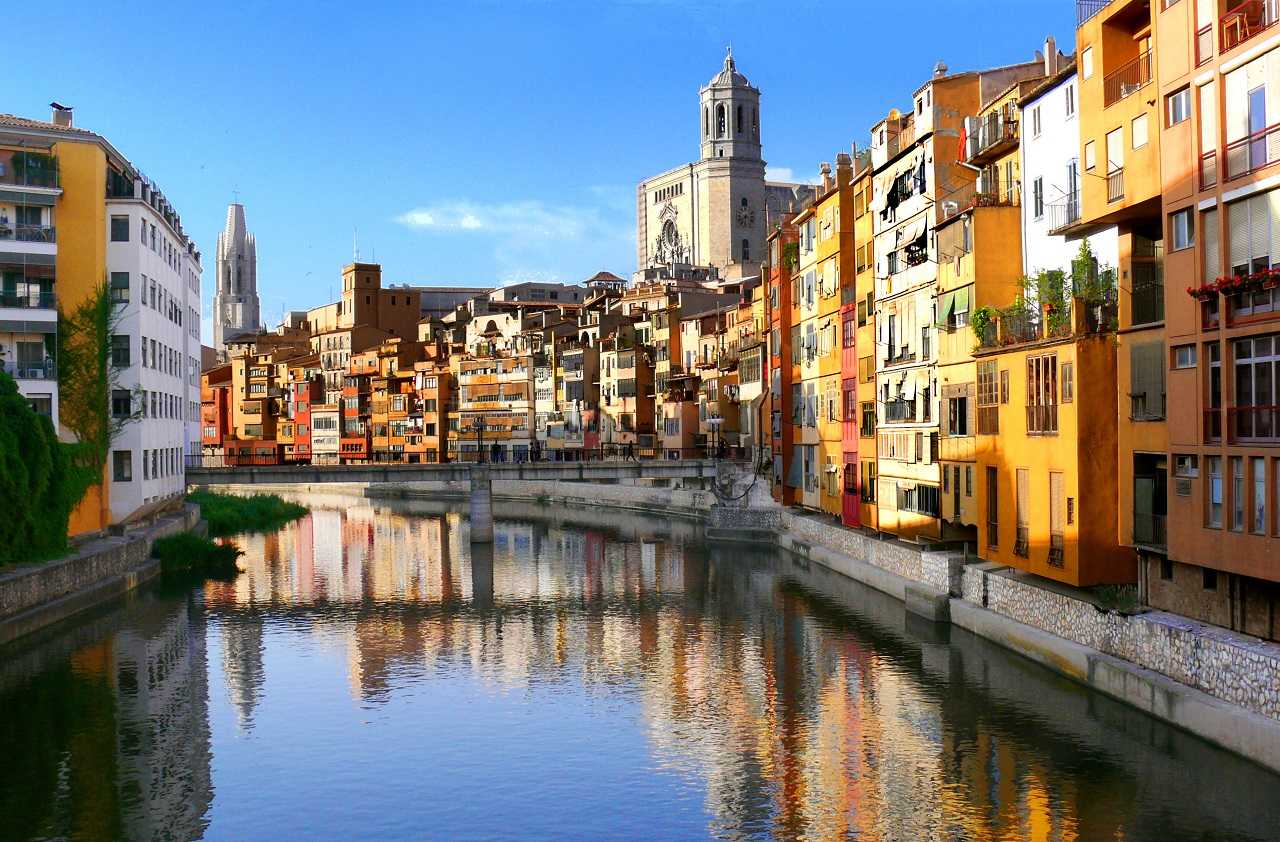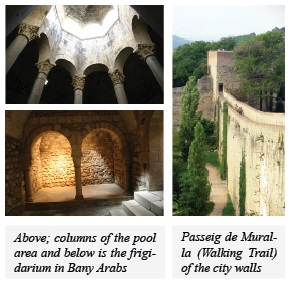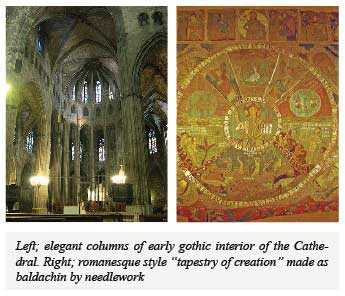Last Updated on 18 January 2018 by TT
Girona Guide
Girona is the fourth largest province of Catalonia with its population of 756.000 population and in the capital of the 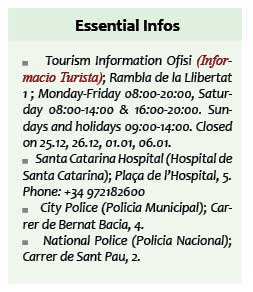 province has a population of 96.000. Located 99 km to the northeast of Barcelona, this city, is visited by too many tourists due to its historical richness. Thanks to the nearby Costa Brava beaches attracting 24 million tourists and the city of Barcelona receiving 10 million tourists, this small city hosts around 5 million tourists each year.
province has a population of 96.000. Located 99 km to the northeast of Barcelona, this city, is visited by too many tourists due to its historical richness. Thanks to the nearby Costa Brava beaches attracting 24 million tourists and the city of Barcelona receiving 10 million tourists, this small city hosts around 5 million tourists each year.
The nearby Girona International Airport, numerous festivals organized each year and the Michelin-starred restaurants in the surroundings all contribute to the tourism revenues beyond expectations. Built on the banks of the Onyar River and surrounded by the historical city walls between the historical city walls, the Girona Old Town (Barri Vell) is one of the best preserved medieval cities of Spain. The world’s best preserved Jewish neighborhood, El Call, constitutes a part of this old city.
How To Go To Girona By Bus Or Train?
The most convenient means of transport between Barcelona and Girona is the train. You can take the train from Sants Estacio or Passeig de Gracia Train Stations. Not all trains departing from Sants Estacio for Girona stop at Passeig de Gracia. Train services start around 07:00 in the morning and prices vary between 15 and 35 € in one direction. Average journey lasts 1:15 hours but there are high-speed trains (AVE) traveling in 37 minutes or regional trains traveling in 2 hours. Though they vary, return services continue until 9, 10 p.m.. Purchasing your train tickets in advance to guarantee your place will be to your advantage.
History of Girona
Girona is founded by Iberians, the first known community of Iberian Peninsula. At that period (500-1000 B.C.) Girona belonged to the Kingdom of Osuna (Ausetani) and was named as “Gerunda”. The city had a special importance because it was on the transportation and trade route between northern Frankish lands and later from Rome to Cadiz, “Via Agusta”. Having settled to the region after Iberians, Romans surrounded the city with a fortress under the same name. After Roman rule Girona was ruled by Visigoths and later by Muslims. Frankish King Charlemagne invaded the city three times in 785, 795 and 797; in 795, he declared Girona as one of the 14 counties of Marca Hispanica. In the 9th century, Girona entered under the rule of Duchy of Barcelona.
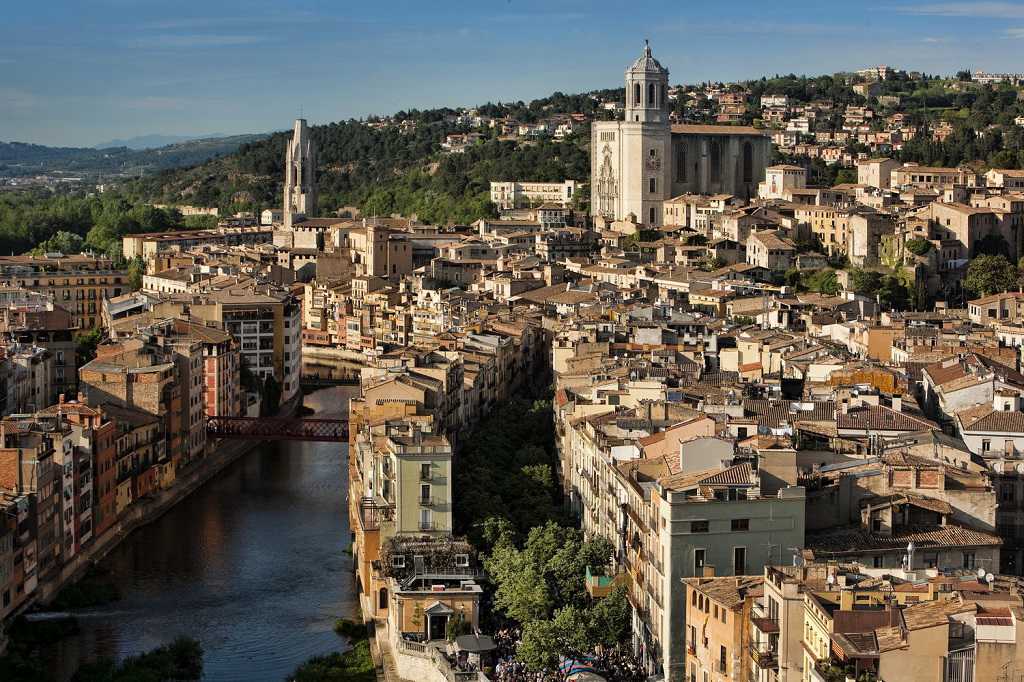
Girona became an important place in the 12th century for Jews since it was home to one of the most important cabalistic schools of Europe. Growing religious pressures in the Middle Ages led the Jews to live in ghettos and finally in 1492, 90.000 Jews who rejected apostasy (most of them were from Girona) were forced to migrate to different countries, primarily to Ottoman Empire.
Through the history, Girona was besieged 25 times but could only be seized 7 times thanks to the strong city walls and brave warriors. Majority of these sieges were claimed by French armies attacking from the north. The most powerful and at the same time the last siege to occur was by Napoleon’s armies of 35.000 soldiers. In 1809, Girona fell after 7 months of resistance. However; Gironians retrieved the city 5 years later by conducting a guerilla warfare and withdrawing to the surrounding mountains.
Orientation
Old town of Girona (Barri Vell) is founded on the east bank of the River Onyar, while modern Girona is on the flat area between Ter and Onyar rivers. Almost all touristic sights worth to see are located in the Old Town and the surroundings. Bus terminal and train station, which are very close to each other, are just a 7-10 minute walk from the Old Town. Modern center and the shopping district of Girona are around “La Plaça de la Independència” which is on the other side of the River Onyar.
Sights to See in Girona
Casas del Onyar (Onyar Houses)
To protect the old Girona from invasions, city walls were also built along the Onyar River. Now you will see a row of colorful houses instead of those city walls. These houses are built after the city walls were demolished during the Napeolonic siege in the 19th century and were painted in pastel colors in the 80’ies to turn them into one of the symbols of Girona. The reflection of the houses on the river, especially on sunny days, must definitely be seen by photographers.
La Lionesa (The Lion of Girona)
 According to a legend, it is believed that if you kiss the bottom the “Female Girona Lion Statue” next to the façade of Saint Feliu Church you will visit Girona again. The original of the sculpture is at the Girona Art Museum.
According to a legend, it is believed that if you kiss the bottom the “Female Girona Lion Statue” next to the façade of Saint Feliu Church you will visit Girona again. The original of the sculpture is at the Girona Art Museum.
Church of Saint Felix (Eslesia de Sant Feliu)
It was built on the catacombs of the city’s bishop African Felix and patron Saint Narcissus in the 4th century. Beside the high altar, there are eight Roman sarcophagis buried in the wall of abscissa. These are Roman characters that supported the construction of the church. On one of the sarcophagi, the portraits of Hades (God of the Underworld in Greek mythology) and Persephone (the vegetation goddess) while being taken to the underworld, could be seen. Another sarcophagus is the tomb of Alvarez de Castro, who built the church and was portrayed while holding a Girona flag with his left hand. While the present construction is predominantly in the Gothic style, due to the extensions between 14th and 18th centuries, it reflects different architectural styles. Gothic nave stands on Romanesque arch and columns. The front façade was built in the 18th century. Even though it is one of the rare churches in Spain which has an original bell tower, the tip of the octagonal tower was destroyed in the 16th century because of a lightning. There are a few exceptional works inside the church like the altar made from alabaster in 16th century and the statue of Leaning Christ from the 14th century.
Banys Arabs (Arab Hammam)
Carrer Ferran el Católic. Entrance Fee; 3 €. Closed on; 01.01, 06.01, 25.12, 26.12. This bath house, which was renovated in 1929, had been built by the Christians in 1194, 300 years after the muslims left Girona. The hammam is in the Romanesque urban style and the most important characteristic of the bath house is that it has been built by imitating a
Roman and/or Muslim bath (possibily by influencing the Muslims’ relations with water and personal hygeine). This bath had been the only bath open to public in Christian Spain since 12th century. Besides sections such as changing room (apodyterium), warm room (caldarium), cold room (frigidarium), room with under-floor heating (tepiderium), there is an octagonal pool and columns that support the prismatic structure.
City Walls and Walks (Passeig de la Muralla)
The most import reason for the city being captured only 7 times in spite of being besieged 25 throughout its entire history is the partly renovated strong castle walls that surround the old city. The part of the walls which encircles the Hill of Montjuic in the north is the oldest section that Romans built. Other parts built by Frankish King Charlemagne in the 9th century were fortified during the 14th and 15th centuries. You can differentiate the old parts and the latter additions by the dimensions and colors of the stones that constitute the city walls. If you go up from the Bath (Bany Arabs) side and walk towards the back of the Cathedral, you can find out the castle walking trail which passes over the walls and can have a panoramic view of the city. However, you have to climb a bit.
Carrer de la Forca / Via Agusta
Roman road which started from Rome and extended up to Spain’s southwest city of Cadiz was passing through Girona. When you enter the city from the castle wall (one of the main portals of the old Girona) near the Cathedral, the present name of the road passing in front of the Cathedral (Carrer de la Forca) was named Via Agusta in Roman times.
Catedral de Santa Maria de Gerona (Girona Cathedral)
Entrance fee is 7 € (including the nave, treasury and courtyard). Free of charge on Sundays (Treasury and Courtyard open until 14:00 hours).
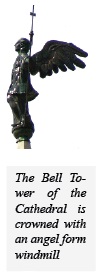 The mosque that remained from the Muslims, which previously was at the place of the church, was completely demolished and the project of the present church was designed by Majorcan architect Jayme Fabre in 1312. However, the construction started only in 1416 in early Gothic style. It is one of the finest cathedrals among all Gothic cathedrals in Spain. Throughout the ages, certain parts of the building have been demolished and rebuilt.
The mosque that remained from the Muslims, which previously was at the place of the church, was completely demolished and the project of the present church was designed by Majorcan architect Jayme Fabre in 1312. However, the construction started only in 1416 in early Gothic style. It is one of the finest cathedrals among all Gothic cathedrals in Spain. Throughout the ages, certain parts of the building have been demolished and rebuilt.
The Cathedral carries Romanesque, Gothic and especially Catalan Baroque characteristics. The front façade which you can climb with 90 steps has a Rococo style staircase with 3 platforms and it is completely Baroque. Inside, there is the tomb of the 11th century Barcelona Count Ramon Berenguer and his wife. The precious altar made from gold and silver was taken away by the French in 1809.
Behind the altar is the marble throne of Frankish King Charlemagne. One of the two bell towers was built in 11th century and in a six-story Romanesque style. This bell tower can not be seen from the front of the building. The other tower built in the 16th century has an octagonal shape and bears the name of Frankish King Charlemagne who conquered Girona from the Muslims.
The Courtyard is the oldest part built in the 12th and 13th centuries. It is in Romanesque style, has an unusual asymmetric form and encircled with double columns decorated by friezes depicting stories from the Bible.
The silver and enameled altar board covered with jewelry at the sanctuary section is from 14th century and worth-seeing. The most important piece among the works in the treasury room is the Tapestry of Creation (Tapís de la Creació) made with very fine needlework during the 11th and 12th centuries. And in the museum, you can see Romanesque paintings, manuscripts, golden and silver works and statues as well.
La Pia Almoina
When you face the front façade of the Cathedral, the stone building on the right hand side of the stairways is one of the most important sample of Catalan civilian architecture and carries the typical characteristics of its era. Built in 1228, the building had served as a house for the poor for many years. Today, it houses the College of Architecture.
Jewish Quarter (El Call) & Jewish Museum
When you face La Pia Almonia and enter into the narrow street on the right hand side, you are in the historical Jewish Quarter of Girona. The alleys on the left hand side of this street, which are about 200 meters long, belong to the Jewish Quarter. With the help of one of the most important Cabalistic schools of Europe which was opened in the 12th century, Girona became an important Jewish city and even the Rabbi of Girona Moshe ben Nahman (1194–1270), was declared the senior rabbi of Spain. Before all the Jews were exiled from Spain and Catalonia in 1492 with the oppression of the inquisition, the Jews survived only by gathering ghetto-wise at certain cities such as Toledo and Girona. At the Montjuic Hill in the north of the city, there still are Jewish cemeteries dating from that era.
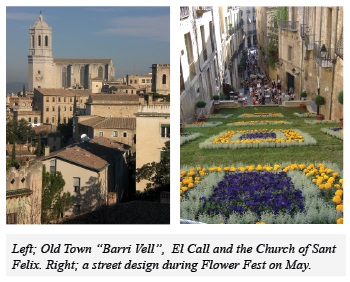 Jewish Quarter (El Call): This is the only Jewish Quarter in Europe of this size and preserved perfectly. In the last years when the oppression increased considerably, the Jews used to close the doors of the gates which they built at the entrance of the narrow streets, especially in the evenings. By this way they used to try to protect their homes and lives like living in an inner fortress. A vast majority of 90,000 Jews brought by ships and accommodated on Ottoman lands with the help of Sultan Beyazit II’s ordinance were coming from El Call district of Girona. Today, there aren’t any Jews living in Girona or in El Call. Except for a few mezuzahs that could be seen at the entrance of few houses, all of the traces belonging to Jews were demolished.
Jewish Quarter (El Call): This is the only Jewish Quarter in Europe of this size and preserved perfectly. In the last years when the oppression increased considerably, the Jews used to close the doors of the gates which they built at the entrance of the narrow streets, especially in the evenings. By this way they used to try to protect their homes and lives like living in an inner fortress. A vast majority of 90,000 Jews brought by ships and accommodated on Ottoman lands with the help of Sultan Beyazit II’s ordinance were coming from El Call district of Girona. Today, there aren’t any Jews living in Girona or in El Call. Except for a few mezuzahs that could be seen at the entrance of few houses, all of the traces belonging to Jews were demolished.
Jewish Museum (Centre Bonastruc ça Porta); Carrer de la Forca, 8. Entrance fee; 4 €. The building of the museum was a place for social gatherings of the Jews living in Girona in the 13th century. The museum aims to introduce and expose the traces of Catalan Jewish community. In the museum Gironian Jewish history and culture is presented under eleven different headings such as “social life, traditions, feasts, life cycle, diaspora and synagogue”.
Girona, yahudi / musevi mahallesi,el call, jewish quarter,
Fiestas in Girona
In addition to fiestas celebrated throughout Catalonia, “Girona Gastronomy Week” organized during spring, “Flower Time” where every part of the city is decorated with gorgeous flower landscapes, “International Music Day” at the end of June, “World Religious Music Festival” organized at the beginning of July, “Jazz Festival” in September, International Theater Festival “Temporada Alta” in December and “Girona Film Festival” are primary annual events. Festival dates may vary. Actual dates and programs of festivals and fiestas in Girona.
Other Touristic Sights To See
* Catolonia Museum of Archeology (Museu d’Arqueologia de Catalunya); Carrer de Santa Llúcia, 8. Phone: +34 972 20 26 32. Entrance Fee 4.5 €. The museum is inside “Sant Pere de Galligants” Monastery, which is one of the significant Romanesque monastery samples of Catalonia
* Museum of Cinema (Museu del Cinema); Carrer Sèquia,1. Phone: +34 972 41 27 77. Entrance fee; 5 €. Spain’s first and only museum of cinema. Here, you can get information regarding the cinema on any subject from traditional Chinese puppets of shadow theatre to Lumiere Brothers.
* Girona Art Museum (Museu d’Art de Girona)
* City History Museum (Museu d’Historia de la Ciutat)
* Saint Pere de Galliant Monastery (Monastery Sant Pere de Galligant); this is a Romanesque monastery that also houses the Archeological Museum.
* Saint Nicolau Church; a 12th century church in Lombard Romanesque style.
* Pont de Ferro; the Bridge on Onyar River connecting the old and the new city which is designed Eiffel company.
* Independence Square (Plaza de Independencia); this main square of the city, which was built to commemorate Girona’s independence from Napoleon armies, is surrounded by cafes and restaurants.
Best Restaurants in Girona
* El Celler de Can Roca; Carrer Can Sunyer, 46. Phone: +34 972222157. Located in the new part of Girona. This very special restaurant with 3 Michelin stars named as the best restaurant of the world by Restaurant Magasine twice in 2011 and 2012. Its style is creative and traditional Catalan cuisine using unusual ingredients. It also has a wine seller of 60.000 bottles. You need to make reservation months ago to assure your table. Costs between 60 €-120 € per person.
* Cal Ros; Cort Reial, 9. Phone: +34 972 219 176. One of the best medium priced restaurants in Girona serving traditional Catalan cuisine. Located nearby Cathedral. Fixed lunch menu (menu del dia) 20 €. Dinner between 35 €-60 € per person.
* Vinil; Cort Reial, 17 baixos. Phone: +34 972 21 64 40. This medium priced restaurant serves Catalan and Mediterraneam food. Location is near to Cathedral. Fix lunch menu (menu del dia) 12 €. Dinner between 30 €- 50 € per person.
